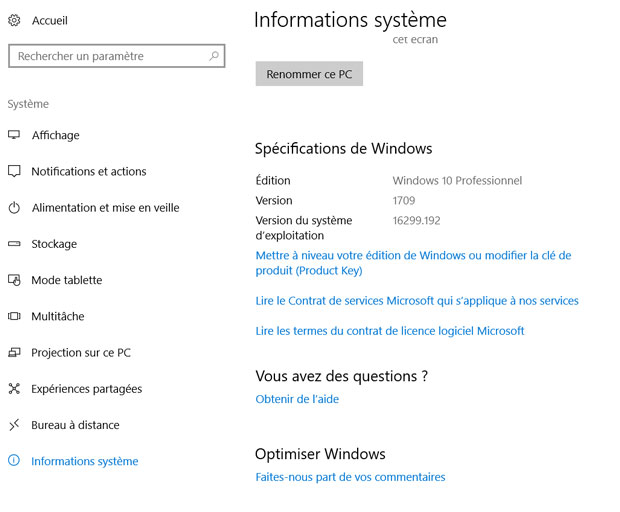Microsoft propose à l’occasion du Patch Tuesday du mois de février 2018 plusieurs mises à jours cumulatives pour Windows 10. En particulier Windows 10 Fall Creators Update (Windows 10 v1709) est visé par KB4074588.
Son installation permet de faire progresser l’OS en version 16299.248. L’information est importante car un bug connu peut provoquer un souci avec l’historique des mises à jour. Il est possible de l’installation soit marquée comme échouée sans raison. Dans ce cas il suffit de se rendre dans « Informations système (Paramètres Windows\Système) pour vérifier la version du système d’exploitation (Spécification Windows).
Windows 10 et KB4074588, sécurité et corrections de bugs
KB4074588 apporte des changements afin d’améliorer la sécurité. Il y a des actions dans Microsoft Scripting Engine, Device Guard, le noyau Windows, Windows Search, Microsoft Edge et Internet Explorer.
Le géant propose également des corrections de bugs. Les détails sont disponibles en fin d’article. L’un d’un concerne une défaillance qui permettait aux comptes enfants d’accéder au mode InPrivate sur les périphériques ARM. D’autres corrections visent le navigateur Microsoft Edge, Internet Explorer et différents petits choses sous Windows 10 comme des erreurs audio surround après un redémarrage.
Microsoft recommande aux utilisateurs d’installer cette mise à jour cumulative dès que possible.
KB4074588
- Addresses issue where child accounts are able to access InPrivate mode on ARM devices even though their browsing and search history is sent to their parents. This occurs only on Microsoft accounts belonging to children that are managed using the Microsoft Family service and for which parents have enabled activity reporting. This applies to Microsoft Edge and Internet Explorer.
- Addresses issue with docking and undocking Internet Explorer windows.
- Addresses issue in Internet Explorer where pressing the delete key inserted a new line in input boxes in an application.
- Addresses issue in Internet Explorer where selected elements wouldn’t update under certain circumstances.
- Addresses issue where some users may have experienced issues logging into some websites when using third-party account credentials in Microsoft Edge.
- Updates time zone information.
- Addresses issue with browser Compatibility View settings that occurs during updates.
- Addresses issue where, in certain hardware configurations, the frame rates of DirectX Games were unintentionally limited to a factor of the display’s vertical synchronization.
- Addresses issue that causes delays when switching keyboard languages using Alt+Shift.
- Addresses issue where surround sound audio endpoints reverted to stereo after restarting.
- Improves and reduces conditions where certain Bluetooth keyboards drop keys during reconnection scenarios.
- Corrects mouse delays for devices that incorrectly report the battery level status.
- Addresses issue where MMC application snap-ins—such as Services, Local Policy Admin, and Printer Management—fail to run when Windows Defender Application Control (Device Guard) is turned on. The error is “Object doesn’t support this property or method”.
- Prevents use of the Pre-production Onesettings endpoint for Windows Setup when test signing is enabled.
- Addresses issue where installations of Windows Server, version 1709 are not automatically activated using the Automated Virtual Machine Activation (AVMA) feature on Hyper-V hosts that have been activated.
- Addresses issue with the Auto-register Inbox templates feature for UEV where the Scheduled Task didn’t have the proper trigger.
- Addresses issue where the App-V client didn’t read the policy for SyncOnBatteriesEnabled when the policy was set using a Group Policy Object (GPO).
- Addresses issue where the Supported On field for the Enable App-V Client policy is blank in the Group Policy editor.
- Addresses issue where the user’s hive data in the registry is not maintained correctly when some App-V packages belong to the connection group.
- Provides additional logging for administrators to take action, such as picking a proper configuration for their App-V package, when there are multiple configuration files for a single package.
- Addresses issue with App-V packages that aren’t compatible with registry virtualization using kernel containers. To address the issue, we changed the registry virtualization to use the earlier (non-container) method by default. Customers who would like to use the new (kernel container) method for registry virtualization can still switch to it by setting the following registry value to 1:
**Path: HKEY_LOCAL_MACHINE\SOFTWARE\Microsoft\AppV\Client\Compatibility
**Setting: ContainerRegistryEnabled
**DataType: DWORD - Security updates to Microsoft Scripting Engine, Microsoft Edge, Internet Explorer, Microsoft Windows Search component, Windows Kernel, Windows Authentication, Device Guard, Common Log File System driver, and the Windows storage and file systems.


Et c’est reparti… 🙁
Cette mise à jour mouline sans fin lors de son installation…
J’ai mis 1 mois à me sortir du blocage précédent et là ça commence à déborder… je sens que je vais vier énergumène…
Bizarre car mes mises à jour ne mouline jamais et s’installe du premier coup, donc problème avec la configuration du pc
Ouf !!! la mise à jour est passée au 4ème essai 🙂
Moi j’en ai marre… elle tourne en boucle depuis 4 jours…. 82 essai